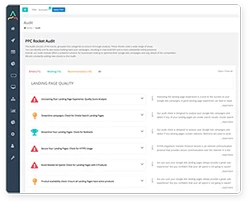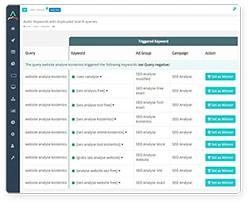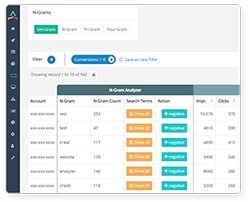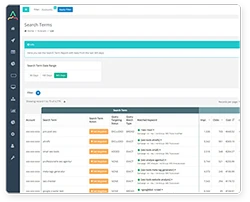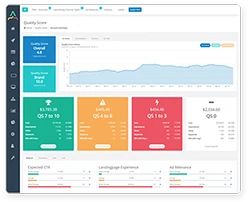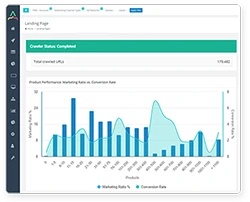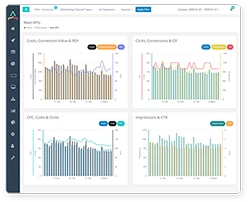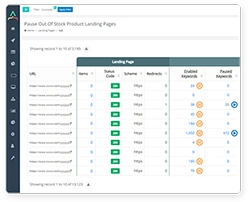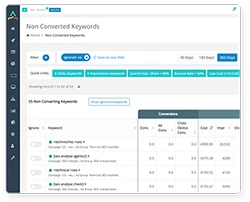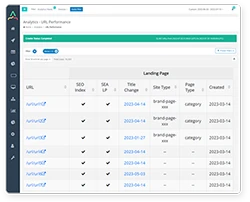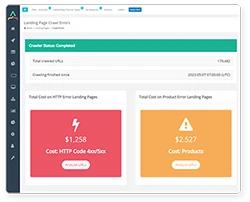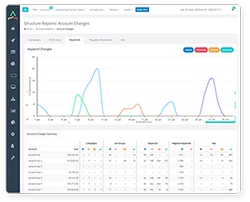Google Ads Account Structure Introduction
Google Ads accounts serve as a potent tool for businesses aiming to advertise on Google and its associated sites. It's a powerful strategy to connect with fresh clients and foster business growth when applied correctly. Nonetheless, it demands a considerable amount of time, expertise, and assistance to master the Google Ads account structure.Start Creating Better Google Ads
See how PPC Rocket can help you achieve best practices when it comes to Google Ads. Optimize your ad spend with all the tools you need to measure, track, and improve performance.
Structuring for Success
Google Ads Account Structure: Organizing your account properly stands as a critical aspect of fully harnessing the platform's capabilities. This involves tailoring your ads to resonate with distinct sections of your precise audience.
In this guide, you'll gain vital insights into how to construct various parts of your account, ranging from Campaigns and Ad Groups to individual Keywords and Ads.
Google Ads Account Structure
A clear account structure is crucial for businesses, as it allows for more targeted control and customization, including brand campaigns.
Deciding to use one or many Google Ads accounts hinges on a few things. Think about how big your business is, how many things you're selling, who you're selling to, and how much you want to spend. Bigger businesses with more money and lots to advertise might want several accounts. It helps them keep things tidy and see what's working. On the other hand, smaller businesses with fewer things to advertise and less money might be just fine with one account.
However, for larger or more complex corporations, it may be practical to establish distinct accounts for varied locations, advertising networks, campaign styles, teams, and business sectors.
For each account or multiple accounts, it's crucial to have a solid understanding of your main objectives and pinpoint exactly which Google Ad Networks you wish to utilize, including the "display network." Ad serving on the display network allows you to reach a broader audience.
Naming Conventions
Imagine being a business with a diverse selection of offerings. The temptation could be high to showcase every item, to lay all your cards out for everyone to see.
Rather than overloading yourself by juggling too many tasks, it's smarter to narrow your focus on a select few significant offerings, especially when it comes to managing your account structure in Google Ads. Perhaps there's a specific item or product category that's consistently popular with customers.
Or perhaps there's a 'bargain bait' - a bargain-priced product you offer to reel in customers. All these factors provide a great place to begin.
Use Your Website
In crafting your new campaign promotional material, always bear in mind this uncomplicated guideline: avoid taking on more than you can handle effectively. While running a venture that provides a myriad of goods or solutions, you might find yourself drawn to promoting each one of them. However, "separate campaigns" with specific targetings can be an excellent solution to this challenge. When you create separate campaigns for specific audiences, you can give them the attention they deserve and tailor your marketing efforts accordingly.
The Power of Organized Ad Groups
Even if you're not a seasoned professional in the realm of Google Ads, this method could end up becoming a mountain of tasks and might spark a bit of bewilderment.
Ad groups are the backbone of a smarter account and campaign structure. By organizing your ads into groups based on related keywords and intention, you can effectively target your messages and maximize your advertising impact for Google searches. Keeping your focus on the key items to spotlight within each ad group ensures a streamlined and efficient campaign.
Google Ads Network
Google Ads offers four primary network types you can dive into search ads, display, video ads, and shopping. By targeting specific search terms, you can effectively reach your desired audience. It's crucial to determine which one you'd like to use before getting your account up and running. Keeping your ads organized can maximize your advertising impact and help you effectively target your messages across these networks.
Search Network: These are Google Ads' usual suspects. They pop up as text when folks search for keywords tied to your business.
Display Network: These chameleons show up on different websites that are part of the Google Display Network. They're handy when you're aiming at certain demographics or hobbies. It's like placing your billboard in just the right neighborhood when you create separate campaigns and ad groups.
YouTube Network: Like a tiny commercial, these run on YouTube, helping you tap into a broad audience. It's your chance to make a mini-movie that markets your business.
Shopping Network: These pop up on Google Shopping campaigns, letting your customers play a quick game of compare-and-contrast with products and prices before deciding to buy.
Campaign Structure
Companies should plan their promotions by thinking about what their customers want to buy. For instance, if a company sells shoes and clothes, they might make different ads for shoes and clothes. But they can also make ads for each step when a customer is thinking about buying, like when they first hear about it, when they're thinking about it, and when they decide to buy.
The good news is that you're free to set up as many as a staggering 10,000 campaigns under just one account, with the flexibility to organize them into numerous ad groups. This makes it pretty straightforward to keep everything in check - unless you happen to offer an unusually vast selection of products or services.
Small-Range Campaign Structures
When planning a campaign, businesses should think about:
Buying mood: Where are their customers in the shopping journey?
Rivals: Is there a lot of competition for what they offer?
Spending: How much can they set aside for ads?
Aims: What's the end goal of their campaign?
Doing this can greatly help you fine-tune your advertisements and guarantee your budget is put to the best use with ad groups.
Large Range Campaign Structures
If you're a big company offering a vast range of products and services, it might be a good idea to use the subcategories from your website to create multiple ad groups.
Businesses have a few simple methods to set up their campaigns. They can arrange by:
Purchase desire: This popular method lets companies show their ads to the right folks just when they're interested.
Target group: This works best when companies really know who they want to reach.
Keyword style: This suits companies that use many keyword styles.
Campaign aim: Perfect for businesses that have clear ad goals.
However, remember that juggling multiple campaigns can get pretty tricky. This is especially true if you're flying solo or working within a small or beginner-level team.
Broader Campaign Structures
The Google Ads account allows advertisers to take two distinct approaches to manage their campaigns effectively, depending on the keyword intent. They can decide to create separate ad campaigns, such as setting up separate ad groups for sales and web traffic, which can simplify matters with multiple ad groups. For businesses with a wide array of offerings and different keyword intents, a wide-scale strategy might be to sort campaigns by keyword match type, still utilizing multiple ad groups. With the Google Ads account, advertisers have the flexibility to implement either of these approaches, including video campaigns and many other campaign types.
Display Campaigns and Keyword Strategies
Additionally, advertisers can also consider incorporating a display campaign into their strategies. By using eye-catching images and engaging ad formats, display campaigns can effectively capture the attention of potential customers across various websites and platforms.
Ad Group Structure
The way you arrange your Google Ads campaign structure will hinge on the variety of products and services you provide. You've got the freedom to create as many as 20,000 ad groups for each of your Google Ads campaigns, or even set up a separate campaign, depending on the campaign type. This generous allowance should completely cover the needs of most businesses, particularly those of small to medium size.
Many businesses lean heavily on their websites to make key choices. Think of your product or service subcategories as the guiding light for your Ad Group. Each ad group can be tailored to these subcategories, ensuring a streamlined campaign strategy.
Location-Based Campaign Optimization
Location targeting lets you pick where your Google Ads appear. This way, you can show your ads to folks in certain places. It's a neat tool to connect with the right people. By doing this, your ads work better and reach the folks you want.
When appropriate for your business, location targeting is a crucial aspect of your campaign structure. By implementing location targeting, you can focus your ads on specific geographical regions where your potential customers are located.
Strategic Ad Grouping
Organizing your ads is super important. It helps you handle ads easily. How you group your ads depends on what you're aiming for and what communication you want to see the potential customer.
Let's say you're advertising a new item. You might put ads together based on what's special about that product. Remember, with Performance max campaigns, you can have 150 ads in one group. It doesn't matter if they're words, pictures, or gallery-style ads.
Enhancing Ad Group Precision
So you're thinking about setting up ads for your shop? Great! Let's make it simple. Imagine you run a store selling men's clothes. Rather than having just one big group for all men's shorts, it's smarter to get specific.
Think of it this way: Break it down into four smaller groups. You'd have one for casual shorts, one for swim shorts, one for sports shorts, and one for cargo shorts. This makes things clearer and easier to handle.
But why stop at shorts? Dive deep. Consider things like how much you want to pay per click (that's the bid strategy) or even using specific keywords that exactly match what people are searching for.
Effective PPC Strategies
PPC advertising resonates with your target audience, yielding better results. Utilize tools like Rocket Keyword Grouper to create Ad Groups effortlessly, even with hundreds of keywords.
Remember, use "negative keywords" and "ad schedule" in Ad Groups for separate campaigns. These separate campaigns prevent unwanted clicks and ensure your ads reach interested individuals.
Use Rocket NGram Tool to effortlessly identify and add keywords to your ad groups, improving your campaign's targeting and effectiveness. Reach the right audience and enhance your advertising efforts.
Landing Pages
Successful non-brand campaigns rely heavily on an impactful landing page, strategically linked to ads. Crafted to convert visitors into leads or customers, these pages enhance campaign performance by offering extra information and clickable areas that entice potential customers to engage.
Optimizing Quality Score and Conversion
They also play a crucial role in determining your Quality Score. They need to be in sync with the keywords you're focusing on. Plus, they should have a persuasive call to action, nudging visitors towards the next step in their customer journey. Pro Tip: Use the Google Ads Quality Score Tool
When crafting your website's ad text, remember to keep "website structure" and "account structure" close at hand. It's essential to make all the critical details a visitor might require to understand the website structure and account structure at the campaign level readily available on your site.
Optimizing Landing Pages with Google Tools
Don't worry, you're not on your own. There's a lot of help online, full of tips and pointers. Even Google pitched in with a free tool named Google Optimize. It helped many businesses, big and small, to test and better their user experiences. But just so you know, Google said they're stopping Google Optimize after September 30, 2023.
Maximizing Conversions with Google Ads Structure
Crafting a top-notch landing page can significantly enhance Google Ads' performance. Aligning ad groups based on the "Google ads structure" can elevate ad rank and boost success chances. This smart tactic links ads to one landing page, maximizing conversions and user experiences through contextual targeting. Focused ad groups around the "Google ads structure" harness relevance and user intent, enhancing the overall impact of the landing page.
Keyword Structure
Getting a Google Ads campaign to perform well hinges greatly on picking appropriate keywords and organizing them well. "Ad group" is a critical aspect of optimizing your Google Ads campaign at the campaign level. By carefully selecting relevant keywords, you can reach your target audience more efficiently.
Having the right keywords isn't just about picking words. It's about reaching the right folks. Think about people who want what you're selling. Your keyword setup, with those handy campaign links, helps you chat with them better.
Here's how to get your keywords spot on:
Look for good keywords using a tool.
Put similar keywords in groups.
Use negative keywords so you don't pop up in unrelated searches.
Always tidy up your keyword list.
By doing these, you'll connect better with folks who matter to you and boost your ads!
Relevant and Specific Keywords
Reaching the right folks is all about the right words. Use words they care about, and your ads will pop up for those who really want what you're selling. This means more clicks and more sales.
Long-tail Keywords
Long-tail keywords? They're just longer, detailed phrases compared to short, general ones. Here's the cool thing: they aren't as competitive. So, you won't have to spend a lot on clicks for your ad. And guess what? People who use them? They're often ready to buy. This means they're more likely to turn into customers.
Negative Keywords
They are simply words or phrases that you wouldn't want to activate in your advertisement. Suppose you are an entrepreneur specializing in women's apparel.
To ensure your advertisement doesn't inadvertently appear in irrelevant Google search queries, you may want to add negative keywords such as "men's" or "boy's." That way, your ad isn't displayed when these terms are the focus of someone's search.
Keyword Match Types
Match types for keywords are a nifty tool that lets you decide how closely a search term needs to match your keyword for your ad to pop up. Essentially, they determine how tight a leash you want to keep on the search terms triggering your advertisements. There are primarily four kinds of match types:
Broad match - Broad match keywords are the most general and will show your ad for any search term that includes your keyword.
Phrase match type - Slightly more specific and will only show your ad for searches that include your keyword phrase in the same order as your keyword phrase.
Exact match type - The most specific and will only show your ad for searches that exactly match your keyword phrase.
Experiment and Research Different Keyword Variations
There's a limitless mix of keywords that can boost your campaigns. The most effective way to discover the perfect blend is by trying out different mixes and versions to see what hits the mark for your business.
You can also turn to handy tools like Google's Keyword Planner for insights on search volume and competitiveness for specific keywords, including "ad group," and to explore new variations worth trying. Google Analytics or the Google Search Console can be another great resource.
It helps you uncover what keywords people are presently using to find your site - this is super useful in discovering new words to add to your 'do not use' keyword list.
Ad Structure and Extensions
Hitting the bullseye with your ads? It's all about the right keywords in your content. Here's the lowdown on doing it right:
Strategic Use of Search Ads and Extensions
You'd do well to include at least a single responsive search ad in every ad group, and at most three, although it largely depends on the traffic pulled in by the ad group. One handy tip? Pin your headlines and descriptions in your responsive search ads.
Don't overlook ad extensions when it comes to your account structure and ad content. These optional extras, such as site links and callouts, offer an edge at the account level, not only in enhancing the visibility and click-ability of your ads but also in offering an extra chance to rise above the competition.
Common Account Structures
We've touched on a few tactics for shaping your campaign's different parts. It's crucial to remember that these setups act as two-sided blades, each presenting its distinct benefits and possible shortcomings. So, without further ado, let's embark on this exploration:
Single Keyword Ad Groups (Skags)
The Single Keyword Ad Group (SKAG) setup has been a popular choice for a long time, mainly because it's pretty straightforward. In this format, each ad group houses just one keyword.
This empowers you to design extremely customized advertisements for that one keyword, enhancing its significance, and thereby increasing both click-through rates (CTR) and Quality Score.
Challenges of Ad Rotation in Google Ads Account Structure
Ad rotation, although an essential component at the ad group level in digital advertising, may not always be consistently feasible for some businesses due to the extensive amount of ad copy required.
For enterprises offering a wide array of products or services, implementing ad rotation at the ad group level could become tremendously labor-intensive, demanding a ton of keywords and ad groups, making the process of ensuring ad relevance even more time-consuming.
Strategic Ad Campaigns: Alpha and Beta
Crafting and managing ad copy for each specific keyword can be challenging and time-consuming, even for smaller businesses utilizing a SKAG (Single Keyword Ad Group) structure at the ad group level.
Imagine setting up two parallel advertising campaigns with identical ads and target keywords. The only twist? They're different in terms of the keyword match type. For the first set, named 'Alpha campaigns', we use exact match terms. These campaigns are laser-focused.
Then we have the second set, called 'Beta campaigns'. Here, at the account level, we switch to the default match type, making it ideal for a search campaign. They're designed to reach a broader audience through the search campaign.
Single Keyword Multi-Match Type Ad Groups
It's a lot like the Alpha/Beta setup, but rather than dividing into two campaigns for multi-match use, you break down the Ad Groups according to match type at the account level. This makes your account simpler to handle.
Additionally, each campaign accumulates more data, which simplifies optimization and facilitates the use of tools like smart bidding.
However, there's a trade-off – you lose keyword-level control for smart bidding and your various match types, including "smart bidding," end up vying against each other. Also, incorporating negative keywords across all your Ad Groups could be a bother in smart bidding.
Message Optimization & Strategy Blending
If you have a handful of key messages you'd like to incorporate into your profiles, it's wise to come up with different ad headlines or descriptions tied to each message. This way, you can gain insight into which particular message and wording are the most striking.
These three strategies are among the main types of Google Ads structures. modern Google Ads experts often blend SKAG and Alpha/Beta, which reportedly mesh well together, offering you the cream of both setups.
Final Thoughts About Google Ads Account Structure
When you're dealing with Google Ads, having a well-planned structure is super important for all your campaigns. Crafting separate campaigns with their own budget and considering device targeting, location targeting, and ad type becomes vital. Taking a thoughtful and strategic approach to arranging your Google Ads account, including your ad groups, can set you up for a smooth ride. This becomes all the more critical as you expand your campaigns and boost your business growth, especially when using broad match groups. By investing time in crafting a nicely ordered Google Ads account, you're sure to save yourself from future headaches and a lot of wasted time.
Expert Assistance with PPC Rocket to Structure Your Google Ads
Now, planning your account structure and ad copy might feel like a steep mountain to climb, especially without the right know-how, experience, and heaps of time to dedicate to it. This is the very reason why countless businesses opt for an extra pair of hands when kicking off with Google Ads, or they prefer to hand over the setup and management completely to experts who can craft compelling ad groups.
Why not touch base with PPC Rocket? Discover how our savvy teams and clever tools can streamline the whole process of planning, structuring, and setting up Google Ads for your enterprise.
Start Creating Better Google Ads
See how PPC Rocket can help you achieve best practices when it comes to Google Ads. Optimize your ad spend with all the tools you need to measure, track, and improve performance.
Share with
Articles
Discover New PPC Marketing Tips, Strategies, and Insights
APRIL 16, 2023

Google Ads - A Marketing Must-Have for SMEs and E-commerce Part 1
Small businesses can now compete with larger companies through digital advertising, specifically Google Ads. This platform provides cost-effectiveness, targeting capabilities, measurable results, and brand awareness options. By leveraging these advantages, small businesses can increase their online visibility, reach their target audience, and drive more traffic to their website.
DECEMBER 04, 2022

19 Tips on Google Ad Management
Previously known as AdWords, it is one of the most effective Pay Per Click (PPC) platforms. It can be an efficient source of traffic and revenue if used correctly.
DECEMBER 20, 2022

Google Ads Account Structure
This article will give you some key advice for structuring different elements of your Account, from Campaigns and Ad Groups to individual Keywords and Ads.
MAY 15, 2023

6 Keys to a Successful and Well-Executed Google Ads Campaign
Google Ads, formerly Google AdWords campaign, is a powerful online advertising platform allowing businesses to display their ads on Google and its partner websites.
4.7 Star (104 reviews)
Customer rating
Start Creating Better Google Ads
See how PPC Rocket can help you achieve best practices when it comes to Google Ads. Optimize your ad spend with all the tools you need to measure, track, and improve performance.
Try PPC Rocket for Free